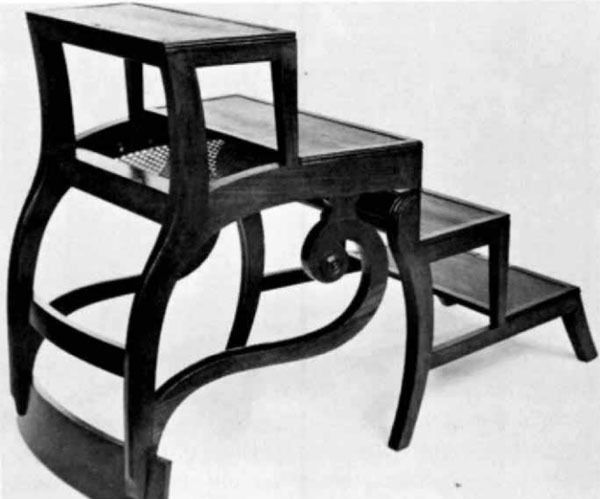Library Ladders
How the British had their steps and hid them too
Synopsis: The idea of creating household pieces to function in two or even three different ways has challenged furniture makers for centuries, writes Alastair A. Stair. The English maker in particular has continually demonstrated a special ingenuity for combination pieces since the 17th century. One specialized form that clearly illustrates the technical devices they created is the English library ladder. The author describes a selection of ladders here and photos show how deceptively they conceal their dual purposes.
The image of a little girl converting the Castro sofa into a bed has been a familiar one to television viewers for years. Convertible furniture however, is not an invention of the twentieth century. The idea of creating household pieces to function in two or even three different ways has challenged furniture makers for centuries. The English maker in particular has continually demonstrated a special ingenuity for combination pieces since the seventeenth century. English technical skill has spawned all manner of technical devices that today delight the collector of English antiques. One specialized form that clearly illustrates this fact is the English library ladder.
Library steps came into general use around 1750, and it is not a mere coincidence that this development was concurrent with the flowering of the Industrial Revolution. Various technical advances made at this time were instrumental in both instigating the need for library ladders and in influencing the forms they were to take.
Fostered by a favorable climate of conditions, the Industrial Revolution began in England toward the middle of the eighteenth century. One of its offspring was the quicker and less costly printing of books. A greatly increased production continued until 1798 when Earl Stanhope of London invented the iron press which made the work even more easy and rapid. As a result, more books were in circulation in the second half of the century than in the previous century, and more attention was devoted to the library and to furniture for it. Books were no longer locked away from view, and new prominence was given to the library breakfront bookcase that was often so tall that the upper shelves could not be easily reached by standing on stools or chairs.
The ladders that were made to meet the need were often cleverly contrived to serve a dual purpose, with form and function uniting in most striking ways. Inspired by the new preoccupation with technical devices, English furniture makers of the eighteenth century, and later in the early nineteenth century, employed simple mechanisms which enabled chairs, stools, book stands and even tables to ingeniously convert into library ladders. Appearing along with straightforward step ladders and pole or “elephant” ladders of all shapes and sizes (sometimes even spiraling, like pulpits) these double-purpose pieces constituted a great variety from which the contemporary gentleman could choose. Playful, sometimes over-ambitious in its attempt to combine beauty of line with practical function, yet often quite elegant in design, the English antique library ladder has a unique appeal for the connoisseur.
From Fine Woodworking #1
For the full article, download the PDF below:
Fine Woodworking Recommended Products

Drafting Tools

Sketchup Class

Drafting Tools






















Log in or create an account to post a comment.
Sign up Log in